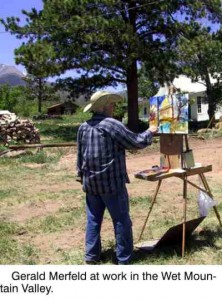Essay by Gregg Mitman
Health – September 2007 – Colorado Central Magazine
“Mom, would you really have shipped me off to Denver?” I asked my mother recently. “Absolutely,” she said.
“But imagine,” I said, “what it would have been like for a 5-year-old living in an institution, surrounded by doctors and a bunch of asthmatic kids?”
“You were very, very sick,” she explained. “Nothing helped.” She told how my doctor had recommended sending me to live at the Children’s Asthma Research Institute and Hospital in Denver. In the 1960s, when I was so sick, this was the best facility for asthmatic children in the United States. For many families, it became a last resort. But, luckily or unluckily for me, it was full up, so I got to stay home.
This talk with my mother helped me understand what propelled thousands of sufferers of asthma, hay fever and consumption, from the 1870s onwards, to abandon family and home to seek relief in the cool mountain air of the Rockies or the dry climate of Tucson.
American writer Helen Hunt Jackson was one such health-seeker. Her decade of seasonal wanderings in search of relief from hay fever ended in Colorado in 1873. Dispatched a year earlier by the New York Independent to write a series about life and landscape on the Western frontier, Jackson found in the Rocky Mountain region “the divinest air” she ever breathed. So divine that she was soon saying goodbye to her friend Emily Dickinson and her beloved White Mountains of New Hampshire to take up residence in Colorado Springs. Once settled, she urged her new community to weigh carefully the value of its healthy air against denuded mountainsides and smoke bestowed by the region’s mining and smelting industries.
Another seeker of health, decades later, was Joseph Wood Krutch, Columbia University professor, drama critic and venerable figure in the New York City literary scene. What compelled Krutch to give it all up in the 1950s to move to Tucson? Asthma.
The sparseness of life, the vast open space of the West, and the warm, dry air brought Krutch not only physical renewal, but also a deepening appreciation for the ecology of the desert and the spiritual meanings he found there. Krutch championed its beauty in his books, The Desert Year and The Voice of the Desert. But by the 1960s, Krutch was horrified by the increasing haze of smoke and dust that was robbing Tucson of its invigorating air. He was also appalled by the spread of lawns that consumed the city’s precious water.
Sadly, the warnings brought by Jackson and Krutch proved warranted. In less than a century, Denver and Tucson became polluted. By the 1960s, Denver’s rapid growth and reliance on the automobile resulted in carbon monoxide and ozone problems as bad as those found in much larger metropolitan areas like Los Angeles.
TUCSON OWED ITS REPUTATION as a haven for allergy sufferers because of the way in which its plants reproduce. Creosote, cacti, and other flora of the desert rely almost exclusively on animals and insects — rather than the wind — to carry their pollen. This quirk of climate and biogeography resulted in allergy relief for Tucson’s health seekers. But newcomers from the East favored the “civilized” look of the cities they’d left, and so planted Bermuda grass lawns and adorned their streets with ornamental mulberry and olive trees. In the 1970s, Tucson’s trees reached maturity, grass pollen and mold spores increased, and native wind-pollinated weeds species like tumbleweed and desert ragweed thrived in newly disturbed soils. In just over 20 years, the atmospheric pollen load of allergenic plant species in Tucson increased ten-fold; the city’s incidence of asthma was now twice, and hay fever six-to-nine times, the national average.
Over the course of a century, the health-giving hope once found in the Western landscape was washed away by the flood of people, industries, transportation, and plants that came with progress.Asthmatics and hay fever sufferers who came West as a last resort found themselves out of place — or at least out of breath — in the promised land. But a new road to Shangri-La appeared, one paved with antihistamines and corticosteroids.
In this happy place, we take a pill or a puff and feel better, while conveniently ignoring how changes wrought upon the landscape have led to the rise of allergy and asthma, not only across Western landscapes, but across the globe.
Gregg Mitman is a contributor to Writers on the Range, a service of High Country News in Paonia, Colorado. He is the author of Breathing Space: How Allergies Shape Our Lives and Landscapes.

